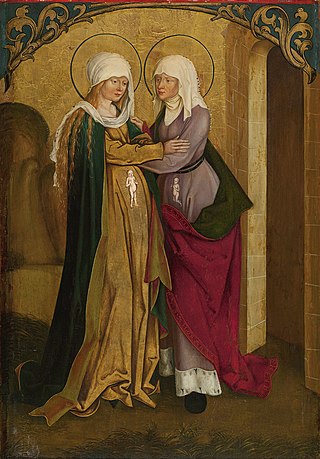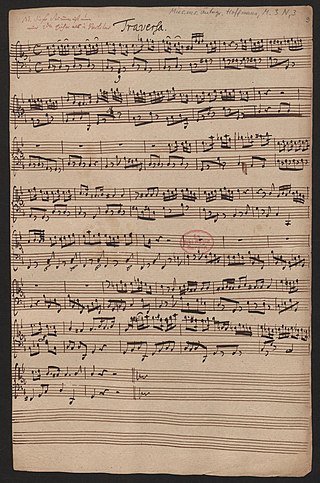Related Research Articles

The Mass in B minor, BWV 232, is an extended setting of the Mass ordinary by Johann Sebastian Bach. The composition was completed in 1749, the year before the composer's death, and was to a large extent based on earlier work, such as a Sanctus Bach had composed in 1724. Sections that were specifically composed to complete the Mass in the late 1740s include the "Et incarnatus est" part of the Credo.
The Bach-Werke-Verzeichnis is a catalogue of compositions by Johann Sebastian Bach. It was first published in 1950, edited by Wolfgang Schmieder. The catalogue's second edition appeared in 1990. An abbreviated version of that second edition, known as BWV2a, was published in 1998.

Johann Ludwig Bach was a German composer and violinist.

In 1724 Johann Sebastian Bach composed the church cantata Meine Seel erhebt den Herren, BWV 10, as part of his second cantata cycle. Taken from Martin Luther's German translation of the Magnificat canticle, the title translates as "My soul magnifies the Lord". Also known as Bach's German Magnificat, the work follows his chorale cantata format.
Throughout his life as a musician, Johann Sebastian Bach composed cantatas for both secular and sacred use. His church cantatas are cantatas which he composed for use in the Lutheran church, mainly intended for the occasions of the liturgical year.

Missa brevis usually refers to a mass composition that is short because part of the text of the Mass ordinary that is usually set to music in a full mass is left out, or because its execution time is relatively short.

Johann Sebastian Bach's Magnificat, BWV 243, is a musical setting of the biblical canticle Magnificat. It is scored for five vocal parts, and a Baroque orchestra including trumpets and timpani. It is the first major liturgical composition on a Latin text by Bach.

Johann Sebastian Bach was a German composer and musician of the late Baroque period. He is known for his orchestral music such as the Brandenburg Concertos; instrumental compositions such as the Cello Suites; keyboard works such as the Goldberg Variations and The Well-Tempered Clavier; organ works such as the Schubler Chorales and the Toccata and Fugue in D minor; and vocal music such as the St Matthew Passion and the Mass in B minor. Since the 19th-century Bach revival he has been generally regarded as one of the greatest composers in the history of Western music.

The cantatas composed by Johann Sebastian Bach, known as Bach cantatas, are a body of work consisting of over 200 surviving independent works, and at least several dozen that are considered lost. As far as known, Bach's earliest cantatas date from 1707, the year he moved to Mühlhausen, although he may have begun composing them at his previous post in Arnstadt. Most of Bach's church cantatas date from his first years as Thomaskantor and director of church music in Leipzig, a position which he took up in 1723.
Most of Johann Sebastian Bach's extant church music in Latin—settings of the Mass ordinary and of the Magnificat canticle—dates from his Leipzig period (1723–50). Bach started to assimilate and expand compositions on a Latin text by other composers before his tenure as Thomaskantor in Leipzig, and he continued to do so after he had taken up that post. The text of some of these examples by other composers was a mixture of German and Latin: also Bach contributed a few works employing both languages in the same composition, for example his early Kyrie "Christe, du Lamm Gottes".

Bach's Missa of 1733, BWV 232 I, is a Kyrie–Gloria Mass in B minor, composed in 1733 by Johann Sebastian Bach. It is an extended missa brevis consisting of a Kyrie in three movements and a Gloria in nine movements. Bach started to compose it, partly based on earlier work, after the death of his sovereign Augustus the Strong, dedicating it to the latter's son and successor, Frederick August II, in a letter dated 27 July 1733. At the time, Bach was in his tenth year as Lutheran church musician in Leipzig, while the Catholic court of the sovereign Elector of Saxony was located in Dresden. Bach sent performance parts of his Missa to Dresden while he kept the autograph score in Leipzig. Upon arrival in Dresden, the Mass was not added to the repertoire of the Catholic court chapel, but instead the parts, and Bach's dedication letter, were archived in the sovereign's library.

Georg Melchior Hoffmann was a Baroque composer who was influential as the leader at the Collegium Musicum in Leipzig. Some of his compositions have been mistaken for those of Johann Sebastian Bach.

Apart from the 1733 Mass for the Dresden court, Johann Sebastian Bach wrote four further Kyrie–Gloria Masses, BWV 233–236. These compositions, consisting of the first two sections of the Mass ordinary, have been indicated as Missae breves or Lutheran Masses. They seem to have been intended for liturgical use, considering a performance time of about 20 minutes each, the average duration of a Bach cantata. They may have been composed around 1738/39. Possibly they were written for Count Franz Anton von Sporck or performed by him in Lysá.

The Kyrie–Gloria Mass for double choir, BWV Anh. 167, is a mass composition in G major by an unknown composer. The work was likely composed in the last quarter of the 17th century. The composition has two sections, a Kyrie and a Gloria, each subdivided in three movements. It has twenty-two parts for performers: twelve parts for singers, and ten for instrumentalists, including strings, wind instruments and organ. Johann Sebastian Bach may have encountered the work around 1710, when he was employed in Weimar. In the 1730s he produced a manuscript copy of the Mass.
Johann Sebastian Bach worked at the ducal court in Weimar from 1708 to 1717. The composition of cantatas for the Schlosskirche on a regular monthly basis started with his promotion to Konzertmeister in March 1714.
Late church cantatas by Johann Sebastian Bach refers to sacred cantatas he composed after his fourth cycle of 1728–29. Whether Bach still composed a full cantata cycle in the last 20 years of his life is not known, but the extant cantatas of this period written for occasions of the liturgical year are sometimes referred to as his fifth cycle, as, according to his obituary, he would have written five such cycles – inasmuch as such cantatas were not late additions to earlier cycles, or were adopted in his oratorios.

Und es waren Hirten in derselben Gegend, BWV 248II, is a 1734 Christmas cantata by Johann Sebastian Bach as the second part of his Christmas Oratorio. Bach was then Thomaskantor, responsible for music at four churches in Leipzig, a position he had assumed in 1723.

Missa Providentiae is a Kyrie–Gloria Mass in D minor composed by Antonio Caldara, which around 1728 was expanded into a Missa tota by Jan Dismas Zelenka: this composer derived a Sanctus and Agnus Dei from Caldara's Kyrie and Gloria, and added a Credo, ZWV 31, of his own hand. Around 1738–1741, Johann Sebastian Bach made a copy of a Sanctus, BWV 239, which was based on the first section of the Gloria of Caldara's Kyrie–Gloria Mass.
References
- ↑ The New Bach Edition, Series II: Masses, Passions, Oratorios at the Bärenreiter website
- ↑ Bach Digital Work 00298
- ↑ "Work 0299". Bach Digital . Leipzig: Bach Archive; et al.
- ↑ Boyd, Malcolm (1999). Oxford Composer Companions: J.S. Bach. Oxford, England: Oxford University Press. pp. 299. ISBN 0-19-866208-4.
- ↑ Cantata BWV 189 Meine Seele ruhmt und preist at www
.bach-cantatas .com - ↑ Georg Melchior Hoffmann: Meine Seele rühmt und preist at www
.carus-verlag .com - ↑ Spitta 1884, p. 374 ff.
- ↑ Frederick Hudson and Alfred Dürr. "An Investigation into the Authenticity of Bach's 'Kleine Magnificat'" in Music and Letters XXXVI (3), 1955 – pp. 233-236
- ↑ Andreas Glöckner. "Die Leipziger Neukirchenmusik und das 'Kleine Magnificat' BWV Anh. 21" in Bach-Jahrbuch 1982, pp. 97-102
- 1 2 3 4 5 6 Kirsten Beißwenger (ed.) Werke zweifelhafter Echtheit, Bearbeitungen fremder Kompositionen (Volume 9 of Series II: Masses, Passions, Oratorios from the New Bach Edition). Bärenreiter, 2000.
- ↑ Mass, a BWV Anh. 24 / Anh. III 167‑>; BNB I/P/6 at www
.bach-digital .de - ↑ Missa (Kyrie and Gloria), C BWV Anh. 25; BNB I/An/1 at www
.bachdigital .de - ↑ Mass, c BWV Anh. 29; BNB I/An/2 at www
.bach-digital .de - ↑ Magnificat in C BWV Anh. 30; BNB I/An/7 at www
.bach-digital .de - ↑ Magnificat in C major BWV Anh 30 at www
.bach-cantatas .com - 1 2 3 Mass in E minor, BWV Anh 166 at www
.bach-cantatas .com - ↑ Geiringer, Karl and Irene. The Bach Family: Seven Generations of Creative Genius, footnote p. 117. New York: Oxford University Press, 1954.
- ↑ Missa (Kyrie and Gloria), e JLB 38; BWV Anh. 166; BNB I/B/18 at www
.bachdigital .de - ↑ Missa, G BWV Anh. 167; BNB I/An/3 at www
.bach-digital .de - ↑ D-B Mus. ms. Bach P 659 at www
.bach-digital .de - ↑ Alfred Dörffel. "Statistik der Concerte im Saale des Gewandhauses zu Leipzig" p. 3, in Geschichte der Gewandhausconcerte zu Leipzig vom 25. November 1781 bis 25. November 1881: Im Auftrage der Concert-Direction verfasst. Leipzig, 1884.
- ↑ Giovanni Pierluigi da Palestrina Missa sine nomine a 6 at www
.bach-cantatas .com - ↑ Missa sine nomine (arr. of Kyrie and Gloria, copy of the following movements) at www
.bach-digital .de - ↑ The New Bach Edition – Revised Edition
- ↑ Morton, Wyant (1992). Questions of authenticity in three motets attributed to Johann Sebastian Bach (Thesis) (PDF). University of Arizona. pp. 11–25.
- ↑ Bach Digital Work 00315
- ↑ Bach-Gesellschaft Ausgabe, .../Prefaces, .../Thematic Catalogue: documentation and facsimiles at the International Music Score Library Project
- ↑ Neue Bach-Ausgabe: documentation at the International Music Score Library Project